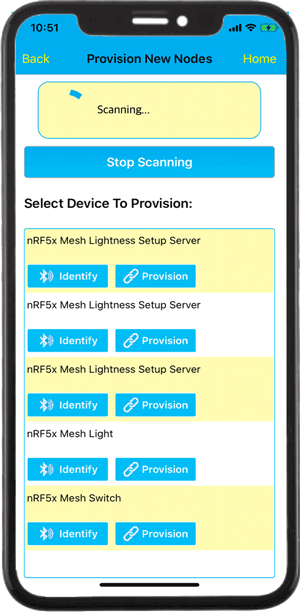"Bluetooth mesh networking is quickly being adopted as the wireless communications platform of choice in a number of control systems,
including advanced lighting solutions for the smart building and smart industry markets."
Bluetooth SIG
A Bluetooth IoT solution that combines a cloud software and a mobile application for the IoT networks management.
Manage Bluetooth mesh IoT networks via the Bluetooth software web dashboard, apply preset configuration to the network devices using a
smartphone and
a mobile application.
How Bluetooth Is Used In IoT
Bluetooth low energy protocol is perfect for IoT devices. IoT devices need to exchange information periodically in the small packets, and preserve
battery - and this is exactly how bluetooth low energy works. BLE devices send out small information packets and go to sleep
until the next data exchange session. This data exchange model works well for the industrial IoT devices, that need to send limited data
to other devices in the network or a gateway periodically.
BLE mesh, developed on top of bluetooth low energy protocol, made BLE devices even more suitable for the IoT networks.
Bluetooth mesh supports many-to-many wireless communication pattern - meaning that each network device can communicate with other
devices in the range.
The mesh topology allows for the creation of the large IoT networks where the data are transferred over the long distance,
far exceeding a regular
bluetooth low energy communication range.
Bluetooth IoT Software Solution At A Glance
In order to manufacture, install and manage Bluetooth IoT networks you need three components:
hardware, firmware and a software and / or a mobile application.
BLE Mesh Commissioning platform is a software solution that allows you to manage, commission and control IoT networks based on
the Bluetooth mesh.
It consists of a web software for the IoT networks management
and a mobile application (Android and iOS) for the network devices commissioning and configuration in the field.
Engineers / administrators
use a Bluetooth IoT software web dashboard to manage smart lighting / smart buildings projects and networks for each project.
Installers or customers use a mobile application to provision on site IoT devices into the network
and apply preset configuration.
BLE Mesh Commissioning software is designed to minimize the amount of work required to create and configure IoT networks
and commission on site devices:
- Do major configuration only once, and re-use it for all new IoT networks.
Define IoT networks functionality (in BLE mesh language it is called an application), create types of IoT devices for each application,
and specify which Bluetooth mesh models are installed on each device type.
- Use visual drag-and-drop interface in the Bluetooth IoT software to create generic IoT device groups. All information on the devices
is re-used, you do not need to re-enter it.
- Create new smart building IoT networks fast using a template for the networks with the similar configuration.
Once template is applied to the network, you can do changes if required.
- Bluetooth IoT mobile application uses minimal amount of navigation and clicks for the network devices commissioning.
An installer can select multiple devices in the mobile application to assign them to the
application and / or group with one click.
The bluetooth IoT software solution is easy to use for the contractors and end users. On site installers do not need to know
details of the BLE mesh internal operations.
They do not have to know what are Bluetooth mesh applications, models, elements, network and application keys, groups,
publisher / subscriber roles, etc.
All details have been already configured by the engineers / administrators via the Bluetooth IoT software web interface.
On site installers just need to
apply preset configuration to the on site devices with the minimal amount of navigation, typing and clicks.
Bluetooth IoT networks configuration parameters are not confined to a specific mobile device.
All authorized software users with the valid login can work with the networks to which they were
given an access by the administrator, on any smartphone or tablet running iOS or Android.
BLE Mesh Commissioning software ensures that users do not interfere with each other working on the same IoT network,
and that network data integrity is not compromised.
Bluetooth IoT Software Solution - Web Interface
Engineers / system administrators use a secure web dashboard for the Bluetooth IoT devices and networks management.
They can create and update multiple smart building projects, manage BLE mesh networks within each project,
define networks configuration parameters,
manage users of the software system and control users privileges.
Creating Bluetooth Mesh Applications And Device Types In The Bluetooth IoT Software

- Use BLE Mesh Commissioning software web interface to create define functionality for your IoT networks
(e.g. Lighting, HVAC, Security - in BLE mesh it is called an application).
Select relevant Bluetooth mesh models for each application.
- Add IoT device types that will be part of each application. For example for the smart lighting application device
types may include
light fixtures, switches and sensors. For the smart building appliances application device types may include
A/C units, heating units and thermostats.
- Select which Bluetooth mesh models are installed on each IoT device type, and assign publisher / subscriber roles.
- You will be using these generic device types to create devices groups for the individual IoT networks.
The BLE mesh models and publisher / subscriber roles are defined only once -
you do not need to repeat the selection for each network group.
- Sometimes a Bluetooth IoT device can be both a publisher and a subscriber.
For example a smart light fixture listens to the switches and sensors (subscriber), and publishes power usage data to the gateway (publisher).
In this case you can create a separate group for each role, and associate each group with the relevant BLE mesh models.
You will be able to apply both groups to the smart lighting fixtures on site using a mobile application.
Managing Smart Building Projects And IoT Networks In The Bluetooth IoT Software
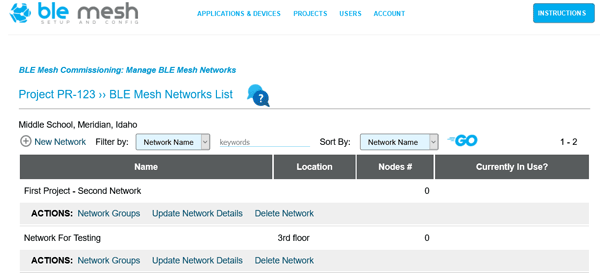
- se BLE Mesh Commissioning software web interface to create smart lighting / smart buildings projects and BLE mesh networks for each project.
- Define configurable network parameters, such as TTL, and network functionality -
select which Bluetooth mesh applications should be a part of the network.
- Use bluetooth IoT software drag-and-drop interface to configure network groups and how they interact.
- If you deploy bluetooth IoT networks with the similar configuration, use a template to quickly create additional networks.
After copying network configuration you can do changes to
the individual networks if necessary.
- Review a list of the provisioned IoT devices and how they are grouped together in each network.
Creating Generic Bluetooth IoT Devices Groups In The Bluetooth IoT Software
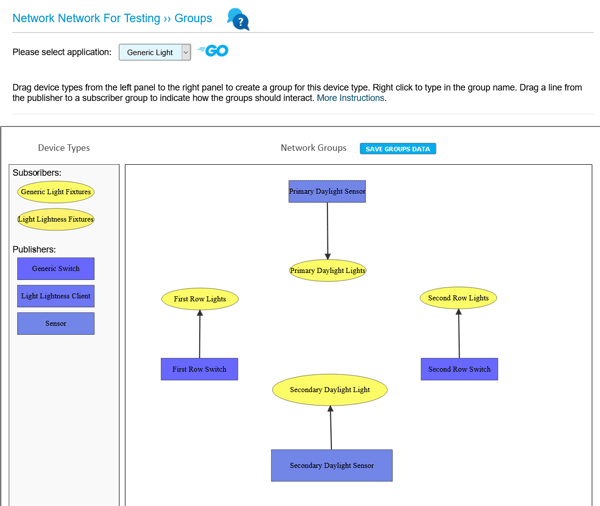
- Use BLE Mesh Commissioning software graphical drag-and-drop interface to quickly create IoT devices groups and define
how these groups interact.
- Pull IoT device type from the right menu to the board to create a new group for the selected device type.
- Type in group name, and connect groups to show which subscriber group should listen to which publisher group.
- Save configuration, and it becomes available to the field installers in the Bluetooth mobile application
for applying to on site IoT devices.
- No repeated manual entries or complex interfaces - create Bluetooth mesh networks configuration in minutes.
Visualize where device groups are located on site and how these groups interact using Bluetooth IoT software web interface.
Bluetooth IoT Software Users And Privileges
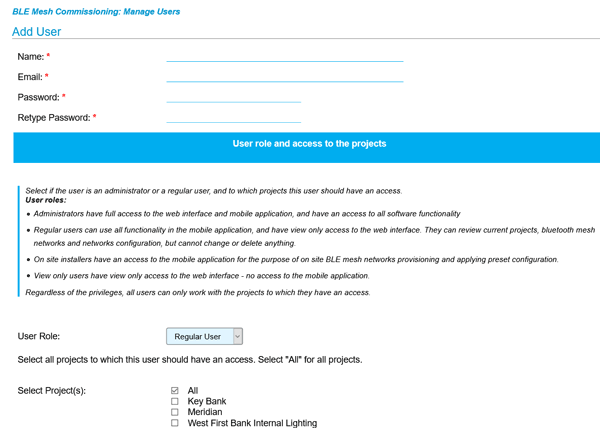
- Control users of the software and users privileges
- Assign users to one, several or all smart lighting / smart building projects
Bluetooth IoT Devices Management On Site In The Mobile Application
Regular users, such as installers and / or customers, use a Bluetooth IoT mobile application for the
networks commissioning: provisioning devices into the network,
applying preset network configuration, and controlling IoT devices parameters / settings.
Provisioning Devices Into The IoT Network In The Mobile Application
- Use a mobile application to scan for the unprovisioned devices.
- Click Identify button to match a device in the list with the actual IoT device on site.
- Click Provision button to add the selected device to the network.
- IoT device is provisioned, and device information is displayed.
- From this point the IoT device is moved to the list of the provisioned network devices
and configuration parameters can be applied to this device.
- You can de-provision an existing network device at any time, or remove a non-functioning device from the list.
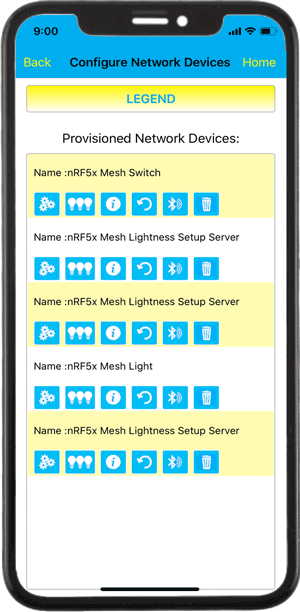
Applying Configuration To The Provisioned Bluetooth IoT Devices
- Once all installed Bluetooth devices are provisioned into the IoT network on site installers can group them together
using preset configuration.
- A mobile application makes the configuration process easy and fast.
Field installers do not need to know any details of the Bluetooth mesh network operations to apply preset
configuration parameters to the on site devices.
- In order to assign Bluetooth mesh applications and groups to the IoT devices an installer selects all applicable
devices from a list in the mobile application and applies the parameters to all selected devices at once.
- Installers can assign an IoT device to multiple groups with one click of a button - no need to apply each group separately.
- Everything that needs to be done for grouping IoT devices - distribute application keys, bind
application keys to the corresponding Bluetooth mesh models, set groups for each element / model combination, assign
publisher - subscriber roles - is done by the Bluetooth IoT mobile application in the background based on the preset configuration data.
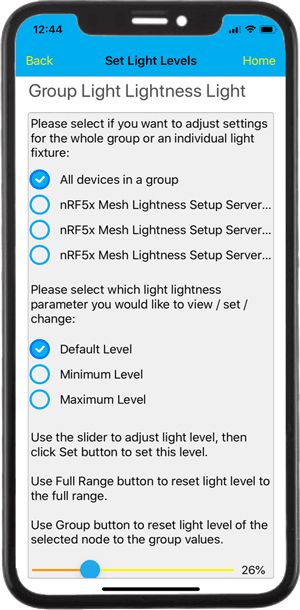
Using Bluetooth IoT Mobile Application For The Network Devices Control
- After you provisioned and configured Bluetooth devices you have a functioning IoT network.
However, often you also need to adjust devices configuration parameters to accommodate the changes in the building occupation and tenants needs.
For example you may want
to change a default light level, timing for the light control time machine, change sensor sensitivity, etc.
The exact adjustable parameters depend on your specific use case and devices you are dealing with.
- Bluetooth IoT application has a built-in option to adjust default brightness level and range for the smart lighting fixtures.
If your smart lighting network includes light fixtures with the Bluetooth mesh Light Lightness model, you can use this built-in functionality.
Otherwise, this option can be replaced or supplemented with
the functionality that will allow you to control and adjust devices parameters for your smart lighting / smart building networks.
- Using built-in smart lighting brightness control you can adjust default light level for an entire group of lights, or for the
individual light fixtures in the group.
- Use a slider in the mobile application to watch the live brightness level changes.
Once you found the right brightness level, set it as a default, minimum or maximum brightness level with a click of a button.
Bluetooth IoT Software Solution With The Central Data Storage
Human interfaces in the Bluetooth IoT software - a web interface and a mobile application - are linked to the central cloud database.
All authorized software users get real time IoT network data regardless of whether they are logged into the
web interface or a mobile application.
The data exchange between the central database and mobile devices / computers is encrypted and secure.
Field installers are not confined to any specific mobile device - they can work with the Bluetooth mesh networks to which they were given an access
by an administrator, on any smartphone or tablet. No manual downloads or data imports
are required - all data exchange happens automatically behind the scene.
Bluetooth IoT software has the locking rules to make sure that the network data integrity is not compromised.
The network is locked to the field installers if someone is already working with it.
After an installer has finished
working with the IoT network and the changes were successfully transmitted to the cloud, the network is unlocked and other users can work with it.
Administrators can check the status of all Bluetooth mesh networks (locked / unlocked), who is working with the locked network and for how long -
and take measures if a network remains locked for too long.




